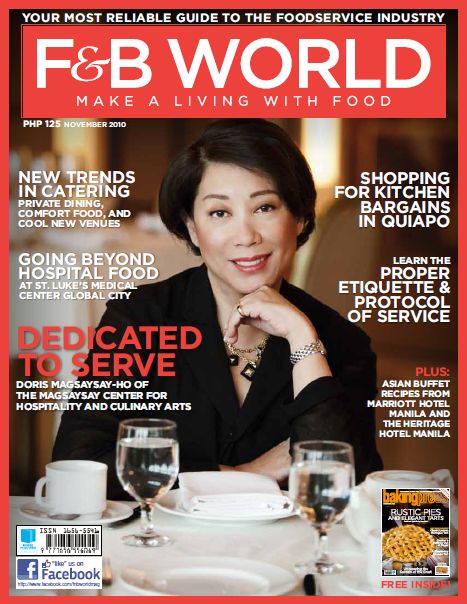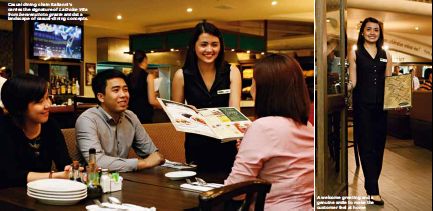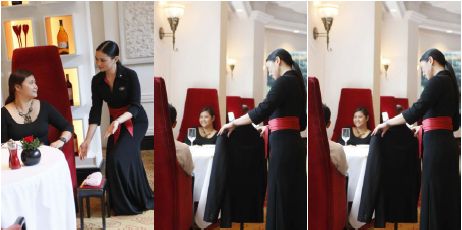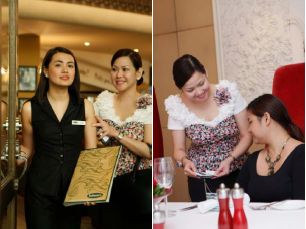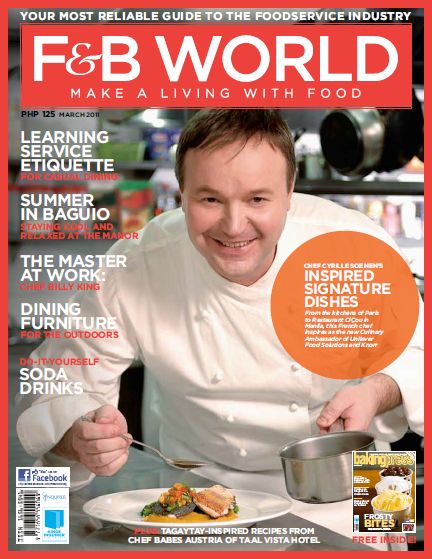The author devises a workable system of Training “Salt” Solutions that determines the right set of service etiquette and protocol for your operations.
By Pauli Antoine

THE POLISHED PRESENCE – From left to right: Mark Villatema’s warm and sincere smile and clean, shaven face; Cherissa Bal’s hands on
her side with thumb and middle finger slightly touching; Mia Laroza’s hands on top of one another in an inverted lotus position; and EJ Asistores’ proper haircut not reaching beyond the mid-section of the ear, not touching the collar, and with sideburns trimmed.
His back is straight, chest out, shoulders relaxed, and hands on the side. Styling and Visual Poise Direction by Pauli Antoine.
The French Court of Louis XIV used étiquettes or little cards to remind courtiers to keep off the grass and later meant ticket of admission. Etiquette is simply knowing how to treat others.
On the other hand, Protocol is derived from the Greek protokollan or “first glue,” from the practice of gluing a sheet of paper to the face of a document to preserve it when it was sealed, imparting authenticity. Today, Protocol refers to rules on how an activity should be performed.
Service etiquette in a restaurant setting is defined as knowing how food should be presented and served given a set of rules. It means taking the Golden Rule a notch higher by treating your guests the way THEY want to be treated.
The truth is, there are no hard and fast rules.
TO EACH RESTAURANT, ITS OWN ETIQUETTE
Rules are important because they are guidelines to what is acceptable and what is not. They are never to be broken—while they are in place. Rules change depending on the need. Just as each society has its own set of rules that evolve over time, each restaurant must keep on reviewing and redefining its own set of service etiquette and protocol.

THE SERVICE ETIQUETTE POSE – Always meet your customer halfway by leaning forward. Bend from the waist and do not stoop. Bend the knees to lower your body. Tilt your head to express warmth. Keep elbows away from the customer.
Coordinating service was critical during the Victorian era because it ensured that the servants worked smoothly together without crashing into each other and dropping plates. Today, observing proper service etiquette is designed to keep guests comfortable. That may sound too simple but there are several aspects that can determine how comfortable a customer feels while dining at your restaurant. How he feels automatically gets filed into his mental black book of restaurant debits and credits. It determines if he will return and what he will tell the world.
Let’s take a look at some of the “hard and fast” Rules of Service.
1 When people are served, the tradition is to start with the Guest of Honor, followed by the women, the men, the Hostess, and finally the Host.
2 If the distinction between guests is not clear, servers start with the oldest woman and work their way down to the youngest man. The same order is followed when taking orders.
3 Plates are served all at once and then cleared all at once so that courses come out together. The idea is that someone who lingers over his or her meal may feel pressured if the plates of other guests are cleared since this may suggest that he or she should dash up.
4 In some restaurants, plates are cleared as people finish.
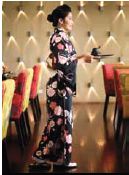
THE IDEAL SERVICE WALK – Be calm and confident with a sense of purpose. Keep eyes focused and alert, chin parallel to the ground, neck pulled back and up, shoulders relaxed and aligned with hip bone, waist pulled up and stomach firmly tucked. Feet should glide on two parallel lines close to one another.
5 Food and drinks are usually served from the left side of the guest and cleared from the right side.
6 There are additional nuances of serving etiquette, some of which can get quite complex. For example, in some establishments, liquids are served from one side, solids from another. Plated food may be served from a different side than foods which are portioned out at the table.7 Japan and some parts of the world, this is reversed, with staff serving from the right and clearing from the left. There may also be cultural norms to observe, such as not handling food with the left hand in the Middle East.
8 Exceptions may be made. For instance, when a guest is leaning to speak to another guest, making it difficult to serve or clear in the conventional style, or when guests are seated against a wall, which makes it logistically difficult to serve and clear from different sides.
Again, these rules sound simple but when not performed properly, guests feel agitated without even knowing why. Oftentimes, they will not be able to express how they feel and they walk away while scribbling on their mental black book—never to return.
HOW TO ARRIVE AT A TRAINING “SALT” SOLUTION
Guest comments are good, but you always have to take them with a grain of salt. As a trainer, the challenge is to digest how guests feel into good Training “Salt” Solutions that can be taught and applied, tailor-made for each restaurant or retail establishment.

WALK WITH LIFE – Carry a sincere facial expression, stride with purpose, maintain good posture. Uniform should be neatly worn, no pens and gadgets on the shirt.
I usually use a scenario of three dining dates: Micky is a regal woman, Louie is a young lady, and King is a CEO. My dining dates are like action figures with different personalities. I dine with each of them exclusively in all sorts of dining places. They are all sticklers for service etiquette but see things from different angles. What King likes is not all that important for Micky. What Louie finds appalling will not even cross King’s mind. Now you know why I don’t dine with all of them together.
I listen carefully to the comments that they dish out when we dine. Their comments are often simply how they feel, and these I diligently jot down in my little black book. Then, I sit down and analyze the situation in four steps:
Step 1: I investigate the Base Scenario, in this case, the reason why guests get so agitated without knowing why.
Louie was so agitated during our date at a casual-dining restaurant’s soft opening. There were no pre-determined service routes. The servers were scrambling around like popcorn. In the eagerness of the servers to deliver the food promptly to each table, they skated around the room like animated cartoon characters, often touching the backrest of the other chairs on our table. Their body language was very stiff. They teeter-tottered awkwardly as they addressed the guests. The crux for Louie was when the server flashed a two-thumbs-up sign to acknowledge her order.
Step 2: I pose Acid Test Questions to each Base Scenario.
1. Did the restaurant have a rule?
2. Was the rule appropriate?
3. Is there a better way? Is there a need to change the rule?
Step 3: I apply the formula: Base + Acid = Salt
You must always run Acid Test Questions on Base Scenarios to produce good Training Salt Solutions.
Step 4: I devise the Training Salt Solution
1. Be controlled. Know and respect invisible boundaries. Establish service routes.
2. Be calm. Walk with life. Move with poise. Lower your body by bending your knees or your torso to meet the guest halfway. Never stoop. Be mindful of guests behind you.
3. Be cordial. Being visually pleasing is not enough. Know the exact tone of professionalism with just the right measurement of charm.
The importance of regular Service Audits becomes apparent. If there is no Base Scenario to work on, the acid will sit in the corner and there will be no salt. In the meantime, customer count dwindles until one day there is none. For restaurateurs, the challenge is to gather as much comments or Base Scenarios from customers, apply the Acid Test Questions, and produce Training Salt Solutions. Then retrain your staff.
When conducting Service Training, it is not enough to issue the basics in the form of a service manual or to demonstrate the standard procedures. It is essential to review each and every step down to the smallest detail and to instill the reasons behind each rule specifically for your restaurant. If sitting on every chair is needed, then do so to determine how service is to be rendered specifically to that guest who will be sitting on that chair. A customer-focused approach to service, and building your own set of Service Etiquette and Protocol are what will separate your restaurant from the rest of the black-book entries.
This article was published in the November 2010 issue of F&B World Magazine, Front of House.
Styling and Visual Poise Direction by Pauli Antoine. Photos by Aldwin Aspillera/Shot on location at UMU Restaurant, Dusit Thani Hotel, Makati City. Models: Mia Laro za and EJ Asistores of UMU Restaurant , Cherissa Bal of Tosca, and Mark Villatema of Basix.
